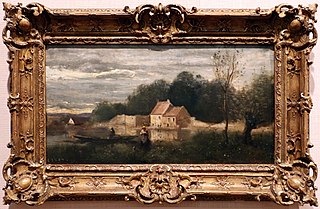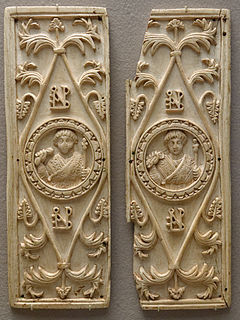 W
WA picture frame is a protective and decorative edging for a picture, such as a painting or photograph. It makes displaying the work safer and easier and both sets the picture apart from its surroundings and aesthetically integrates it with them.
 W
WThe conservation and restoration of painting frames is the process through which picture frames are preserved. Frame conservation and restoration includes general cleaning of the frame, as well as in depth processes such as replacing damaged ornamentation, gilding, and toning.
 W
WA digital photo frame is a picture frame that displays digital photos without the need of a computer or printer. The introduction of digital photo frames predates tablet computers, which can serve the same purpose in some situations; however, digital photo frames are generally designed specifically for the stationary, aesthetic display of photographs and therefore usually provide a nicer-looking frame and a power system designed for continuous use.
 W
WA diptych is any object with two flat plates which form a pair, often attached by hinge. For example, the standard notebook and school exercise book of the ancient world was a diptych consisting of a pair of such plates that contained a recessed space filled with wax. Writing was accomplished by scratching the wax surface with a stylus. When the notes were no longer needed, the wax could be slightly heated and then smoothed to allow reuse. Ordinary versions had wooden frames, but more luxurious diptychs were crafted with more expensive materials.
 W
WA drop top guest book is an alternative to the traditional guest book used at events such as weddings, birthday parties, and baby showers. Instead of guests signing their names on a sheet of paper or in a booklet, they sign an item that is to be inserted, or dropped, into a shadow box frame. The pieces that are typically signed on and dropped into frame are wooden and come in various shapes, with hearts being the most common.
 W
WIn the picture framing industry, a fillet is a small piece of moulding which fits inside a larger frame or, typically, underneath or in between matting, used for decorative purposes. The picture framing term is probably related to, though not necessarily derived from, the engineering term, which it is frequently pronounced similarly to; however, unlike the use of fillets in mechanical engineering, the use of "fillets" in picture frames is wholly decorative.
 W
WGallery wrap is a method of stretching an artist's canvas so that the canvas wraps around the sides of the stretcher bar or strainer bars and is secured to the back of the wooden frame.
 W
WGilding is a decorative technique for applying a very thin coating of gold to solid surfaces such as metal, wood, porcelain, or stone. A gilded object is also described as "gilt". Where metal is gilded, the metal below was traditionally silver in the West, to make silver-gilt objects, but gilt-bronze is commonly used in China, and also called ormolu if it is Western. Methods of gilding include hand application and gluing, typically of gold leaf, chemical gilding, and electroplating, the last also called gold plating. Parcel-gilt objects are only gilded over part of their surfaces. This may mean that all of the inside, and none of the outside, of a chalice or similar vessel is gilded, or that patterns or images are made up by using a combination of gilt and ungilted areas.
 W
WIn the picture framing industry, a mat is a thin, flat piece of paper-based material included within a picture frame, which serves as additional decoration and to perform several other, more practical functions, such as separating the art from the glass. Putting mats in a frame is called matting, a term which can also usually be used interchangeably with mat. The French term, occasionally used in English, is passe-partout. A picture is placed beneath it, with the cutout framing it. The passe-partout serves two purposes: first, to prevent the image from touching the glass, and second, to frame the image and enhance its visual appeal. The cutout in the passe-partout is usually beveled to avoid casting shadows on the picture. The French word may also be used for the tape used to stick the back of the picture to its frame.
 W
WOliver Brothers Fine Art Restoration and Conservation is believed to be the first art restoration establishment in the United States. For more than one and one-half centuries, the Olivers and their successors have restored and conserved antique and contemporary paintings, original works on paper, fine art prints, icons, murals, original photographs, documents, sculpture, gilded objects, and picture frames for private collectors, museums, art dealers, auction houses, galleries, corporations, universities, historical societies, libraries, and others.
 W
WIn the picture framing industry, a mat is a thin, flat piece of paper-based material included within a picture frame, which serves as additional decoration and to perform several other, more practical functions, such as separating the art from the glass. Putting mats in a frame is called matting, a term which can also usually be used interchangeably with mat. The French term, occasionally used in English, is passe-partout. A picture is placed beneath it, with the cutout framing it. The passe-partout serves two purposes: first, to prevent the image from touching the glass, and second, to frame the image and enhance its visual appeal. The cutout in the passe-partout is usually beveled to avoid casting shadows on the picture. The French word may also be used for the tape used to stick the back of the picture to its frame.
 W
WPastiglia [paˈstiʎʎa], an Italian term meaning "pastework", is low relief decoration, normally modelled in gesso or white lead, applied to build up a surface that may then be gilded or painted, or left plain. The technique was used in a variety of ways in Italy during the Renaissance. The term is mostly found in English applied to gilded work on picture frames or small pieces of furniture such as wooden caskets and cassoni, and also on areas of panel paintings, but there is some divergence as to the meaning of the term between these specialisms.
 W
WA polyptych is a painting which is divided into sections, or panels. Specifically, a "diptych" is a two-part work of art; a "triptych" is a three-part work; a tetraptych or quadriptych has four parts; pentaptych five; hexaptych six; heptaptych seven; octaptych eight parts; enneaptych nine; and decaptych has ten parts.
 W
WThe Professional Picture Framers Association / PPFA is an international trade organization serving the art and framing community worldwide since 1971. Members include independent frame shop owners and staff, distributors and manufacturers of picture frame mouldings, supplies and equipment, art galleries, artists, and other businesses in the custom picture framing industry.
 W
WA riza or oklad, sometimes called a "revetment" in English, is a metal cover protecting an icon. It is usually made of gilt or silvered metal with repoussé work and is pierced to expose elements of the underlying painting. It is sometimes enameled, filigreed, or set with artificial, semi-precious or even precious stones and pearls. Although the practice of using rizas originated in Byzantine art, the Russian term is often applied to Greek icons; in Greek the term is επένδυση ("coating"). Icons are described as επάργυρες or επίχρυσες: silver-covered and gold-covered, respectively.
 W
WA stretcher bar is used to construct a wooden stretcher used by artists to mount their canvases.
 W
WA triptych is a work of art that is divided into three sections, or three carved panels that are hinged together and can be folded shut or displayed open. It is therefore a type of polyptych, the term for all multi-panel works. The middle panel is typically the largest and it is flanked by two smaller related works, although there are triptychs of equal-sized panels. The form can also be used for pendant jewelry.